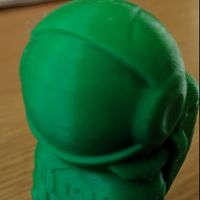Higher input voltages for steppers
-
I'm developing high-speed custom pen-plotters, that work basically like a 3D-printer. Since I'm running at very high speeds (up to 5000 mm/s) I need very high voltages to drive the steppers (6 steppers per printer). At the moment I'm running at 48V @ 3A_rms and would like to go higher.
The TMC5160 allows input voltages of up to 60V, is there any possibility to make a high-voltage version of the Duet 3? Or modify the Duet 3 to at least 48V? I'm good at soldering, I just need to know which components to replace.
-
The limiting components are the 5V regulator (AOZ1284) and the 12V regulator (TS30041) which are rated to 40V. Some of the capacitors in the 5V and 12V regulator circuits may be rated to 35V only, although I know that we often use 50V capacitors there.
You can manage without the 5V regulator if you provide external 5V power, however 12V is needed for the TMC5160 driver chips.
Probably the simplest way to allow up to 48V would be to remove diode D3 and feed between 12V and 30V to the pad that the cathode was connected to, to power the 5V and 12V regulators.
To go higher than 48V, you would need to replace the six 220uF 50V electrolytic capacitors.
HTH David
-
Thanks, so it seems it's possible with a little bit of soldering.
Since Klipper isn't available for the Duet 3, I might have to go away from Klipper to follow ths path. The main reason I'm using klipper are the high step rates I can achieve. With my SKR Pro over 900k steps/s are possible (bottom table): https://github.com/KevinOConnor/klipper/blob/master/docs/Features.md
What is the maximum steprate the Duet 3 can output?
-
Since you're moving a light load you might find the drive mechanism I used in my corexy sand table to be useful in achieving high speeds. I was trying to keep the motors running quietly as I drove the sand table at 500 mm/sec. I found that at speeds much higher than 100 mm/sec, the motors started getting noisy, so I used a loop belt and two pulleys to step up the motor speed by 5x (later reduced to 4x) so that I could use 256:1 ustepping even as the mechanism ran (relatively) quietly at 500 mm/sec. At 5:1, the motor was turning at 1.25 revs/sec to move the magnet at 500 mm/sec.

Stepping motor speed up this way also divides torque, but it works OK for a low mass, low friction mechanism. You also give up some resolution- IRIC the drives are set for 80 usteps (at 256:1 uninterpolated) per mm.
-
Thanks for your suggestion. Stepping up the motors reduces acceleration, while improving max. velocity. Since I am optimizing for small line segments, acceleration is more important to me. The max. possible system acceleration is reached when the reflected load inertia matches the motor inertia. I calculated all gear ratios based on this principle, which is why my motor pulleys range from 15 to 70 mm in diameter depending on the use-case.
Since different motors have different inertias and different torque ratings, I select the best motor from a large table of possible motors, where I assume for every motor that it will be driven with it's individual optimum gear-ratio.
So unfortunately I can not improve system performance by changing to a different motor or gear ratio (if I didn't make any mistakes, I should already be at the optimum)
My limitation is therefore voltage and current. My self-built setup allows me to run at 48V@3A_rms. Raising at least one of these two would allow me to run new motor/gear-ratio combinations, that are not possible right now.
-
@dc42 I think the AOD4184A mosfet and the Schottky CDBA540-HF would not be able to work above 40 volts, so the solution of removing the D3 diode and externally powering the regulators can be dangerous. It is right?
-
@nomad said in Higher input voltages for steppers:
@dc42 I think the AOD4184A mosfet and the Schottky CDBA540-HF would not be able to work above 40 volts, so the solution of removing the D3 diode and externally powering the regulators can be dangerous. It is right?
Correct, you would need to not use the AOD4184A outputs at all, or use a different supply to power the heaters.
-
@dc42 has anyone carried out the modifications on the boards to allow higher voltage?
-
 undefined Chriss referenced this topic
undefined Chriss referenced this topic
-
Actually come to think of it, what would be the cost of manufacturing boards with these additional components instead? Is this something that could be achieved at a low rate of production with a pick and place, or via a PCB service?
-
@jrow I know an electronics tech whose day job is fixing production errors in dense PCBs that hires out her spare time. I'd love to mod a 6HC to 50 or 60VDC.
-
 undefined jay_s_uk referenced this topic
undefined jay_s_uk referenced this topic